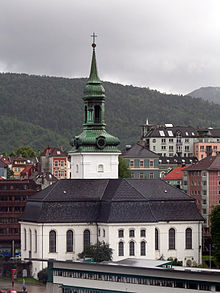- Nykirken
-
Nykirken (literally: The new church) is a cruciform church located in Bergen, Norway.[1] It is located at Nykirkeallmenningen between Strandgaten and Vågen. Although it is generally known as the Nykirken, it was consecrated in 1622 by Bishop Niels Paaske as 'Holy Trinity Church'.[2]
History
The church was originally built in 1621 on the site of the ruins of the home of the archbishop, a stone building that was built in the 14th century, and was destroyed by fire.[3] The church only stood for two years before it burned down in 1623. It was immediately rebuilt.[1] In 1660 the church was again destroyed by fire and again rebuilt in 1670. Later fires happened in 1756 and in 1800.[1]
20 April 1944, during World War II, the church was once again destroyed when the German ship Voorbode exploded in Vågen leaving large parts of Bergen in ruins.[4][5] The reconstruction followed the plans of the church built after the fire in 1756, including the spire called for in these plans but not built.[1] Johan Joachim Reichborn is the architect.[6]
Internal features
The church has 750 seats, somewhat less than before 1944.[1] The great majority are in high-sided box pews, although there are also some painted wooden benches, more suitable for children.
The church is informally known as 'the Children's Church' following the desire of a former Bishop of Bergen to develop this use. In consequence the interior has been largely decorated by local children. These decorations include hand-painted icons, hanging mobiles, and large paintings that have been set into double-glazing panels to form a satined glass effect at every window in the main church building.
The 'Baptismal Angel' is a massive carved angel which descends from the ceiling of the church by means of a pulley system, bearing in its hand the bowl for infant baptsms. The original was donated in 1794 in memory of Heinrich Pütter[2], but was destroyed in the 1944 explosion. The replacement was donated by Bergen Cathedral, who had always been the owners of the matching angel, but kept it unused in storage. The mechanism for the angel is now electrically operated.
References
- ^ a b c d e Hartvedt, Gunnar Hagen (1994). "Nykirken" (in Norwegian). Bergen Byleksikon. Oslo: Kunnskapsforlaget. p. 354. ISBN 8257304859.
- ^ a b (in Norwegian, German, & English) Nykirken i Bergen, Bergen: Nykirken (church guide), p. 4
- ^ Hartvedt, Gunnar Hagen (1994). "Erkebispegården" (in Norwegian). Bergen Byleksikon. Oslo: Kunnskapsforlaget. p. 168. ISBN 8257304859.
- ^ Lavik, Per Jahn (1993). Brekke, Nils Georg. ed (in Norwegian). Kulturhistorisk vegbok Hordaland. Bergen: Hordaland Fylkeskommune. p. 70. ISBN 82-7326-026-7.
- ^ Henriksen, Petter, ed. "Vågen – eksplosjonskatastrofen 1944" (in Norwegian). Store norske leksikon. Kunnskapsforlaget. http://www.snl.no/V%C3%A5gen/eksplosjonskatastrofen_1944. Retrieved 12 June 2009.
- ^ Indahl, Trond. "Johan Joachim Reichborn". Norsk biografisk leksikon. Oslo: Kunnskapsforlaget. http://www.snl.no/.nbl_biografi/Johan_Joachim_Reichborn/utdypning. Retrieved 22 June 2009.
Coordinates: 60°23′49.448″N 5°18′48.132″E / 60.39706889°N 5.31337°E
Categories:- Churches in Bergen
- 1621 establishments in Norway
- Buildings and structures destroyed during World War II
- Norwegian church stubs
Wikimedia Foundation. 2010.

